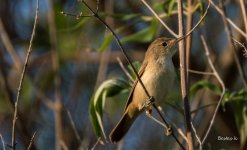-
Welcome to BirdForum, the internet's largest birding community with thousands of members from all over the world. The forums are dedicated to wild birds, birding, binoculars and equipment and all that goes with it.
Please register for an account to take part in the discussions in the forum, post your pictures in the gallery and more.
You are using an out of date browser. It may not display this or other websites correctly.
You should upgrade or use an alternative browser.
You should upgrade or use an alternative browser.
Warbler,Northern Greece (1 Viewer)
- Thread starter ody
- Start date
More options
Who Replied?AlinoVegano
Well-known member
I'd say Reed Warbler but not sure
Purple Heron
Well-known member
Not a reed warbler. Looks like a chiffchaff to me though the eye-stripe is not clearly defined in this photo. Not many warblers have black beak and legs. I'd go with chiffchaff.
AlinoVegano
Well-known member
Not a reed warbler. Looks like a chiffchaff to me though the eye-stripe is not clearly defined in this photo. Not many warblers have black beak and legs. I'd go with chiffchaff.
Long undertail coverts, rounded, almost wedge-tail tip, long beak not that thin all exclude Phyllosc. I stick on Acrocephalus.
Mark Lew1s
My real name is Mark Lewis
It certainly looks like an acro to me.
Simon Wates
Well-known member
Acro for me too - colouration suits Reed
Nutcracker
Stop Brexit!
Acro for me too - colouration suits Reed
And me.
Simon Wates
Well-known member
Acro. No idea how folks are getting to reed though with the warm lighting and lack of wing we can see.
Nobody has said its a RW - just that it seems right
Probably is one though.....
AlinoVegano
Well-known member
Nobody has said its a RW - just that it seems right
Probably is one though.....
Yeah, Reed Warbler is the commonest Acrocephalus over there, and nothing on the photo excludes it, so it is likely to be one. Likely.
Purple Heron
Well-known member
It might help to work out what this bird is if you told us where you found it. The background of the photo doesn't look like reeds and I still think it looks more like a chiffchaff than a reed warbler.
Andy Adcock
Worst person on Birdforum

It might help to work out what this bird is if you told us where you found it. The background of the photo doesn't look like reeds and I still think it looks more like a chiffchaff than a reed warbler.
With a tail like that, no offence meant but how much birding have you actually done?
Acrocephalus warblers, of which this is one, are often seen in habitat other than reeds.
A
Simon Wates
Well-known member
It might help to work out what this bird is if you told us where you found it. The background of the photo doesn't look like reeds and I still think it looks more like a chiffchaff than a reed warbler.
At this time of year (post breeding migration time underway for RW) they often appear anywhere - often in arid habitats (esp. in Med Europe) even pine trees and such like. Of course, its not stated when the photo was taken but looks as a 1stW to me - if it is, its likely moving.
Look at the UTCs - although in shadow, they extend far down the undertail, legs are far too stocky for CC and the peachy rufousy wash to the breast sides, under belly and UTCs are typical RW. The bill alone is wrong for CC etc.
Rotherbirder
Well-known member

Without question an Acro. Quite apart from the other genus-defining features already mentioned, look at the length and shape of the bill - clearly not that of a Phyllosc.
Purple Heron
Well-known member
The reason I suggested chiffchaff is that there aren't, as far as I know, any acros that live in/pass through Greece which have black legs and a black bill. So can anybody actually identify this bird?
AlinoVegano
Well-known member
The reason I suggested chiffchaff is that there aren't, as far as I know, any acros that live in/pass through Greece which have black legs and a black bill. So can anybody actually identify this bird?
It is Acrocehalus sp, with 99% probability to be Acrocephalus scirpaceus. Colour including legs, and shape are matching perfectly.
Simon Wates
Well-known member
The reason I suggested chiffchaff is that there aren't, as far as I know, any acros that live in/pass through Greece which have black legs and a black bill. So can anybody actually identify this bird?
Bill and legs aren't black though - remember a photo is an instant in time and their true colour would be revealed as the bird moved - a shot taken after or before this one for example. The bird is confidently identified as an Acro sp. and very likely to be a Reed Warbler - the other contenders don't fit too well. PH - its lores and facial pattern are spot on for RW, apart from all the other features mentioned - look at the bird again please
Users who are viewing this thread
Total: 2 (members: 0, guests: 2)




